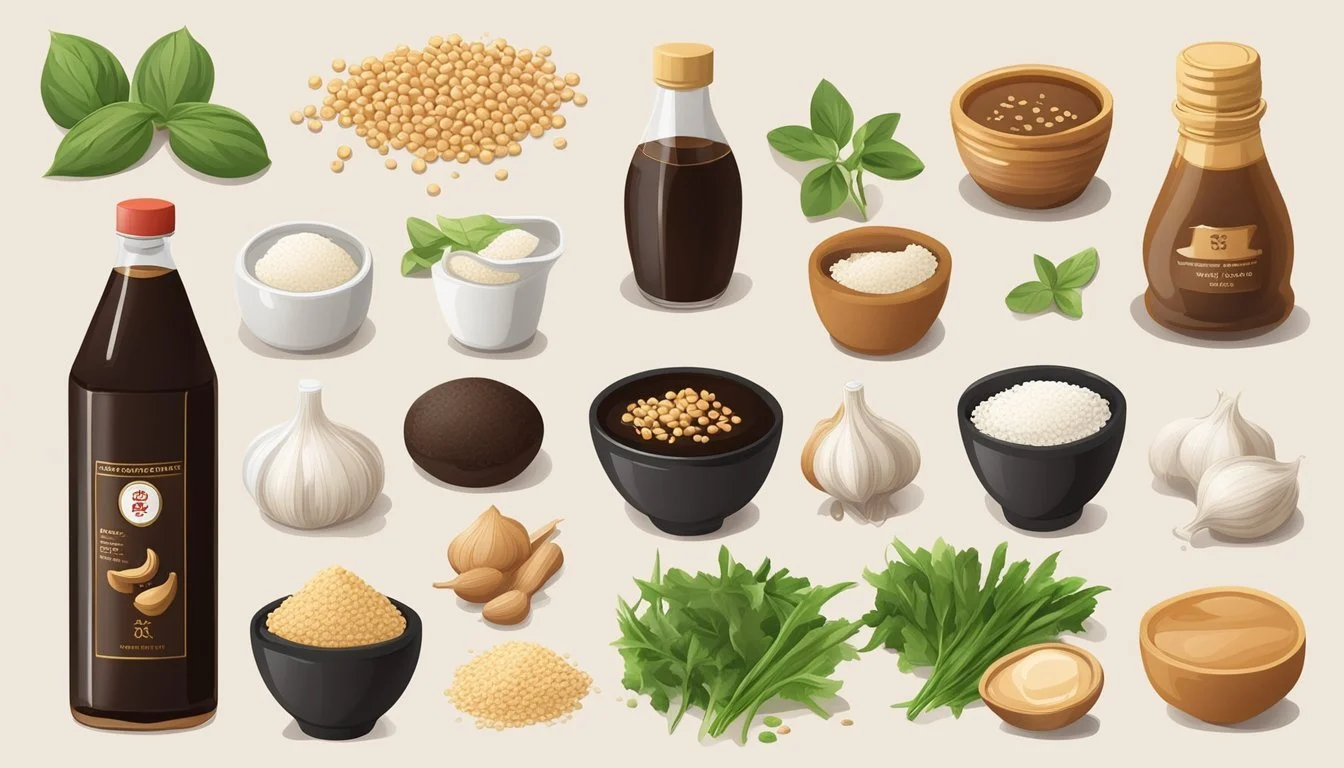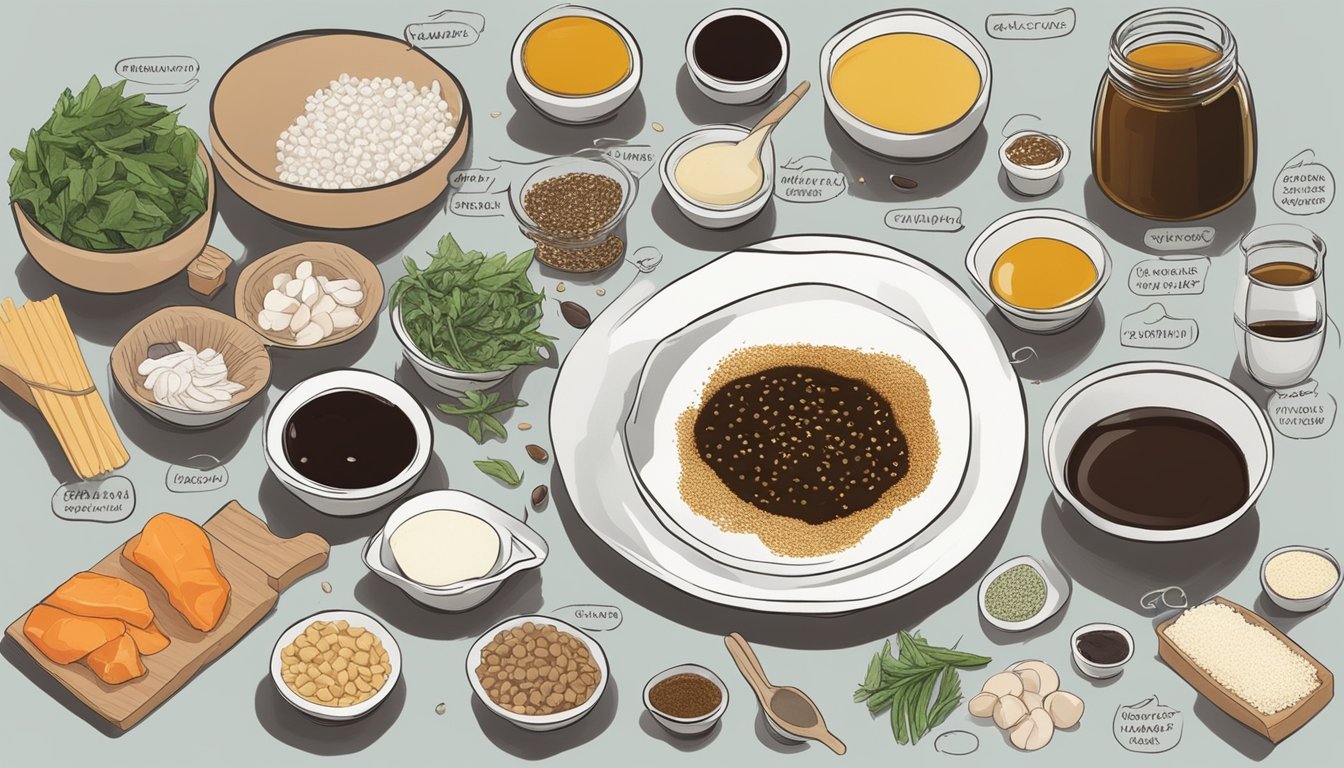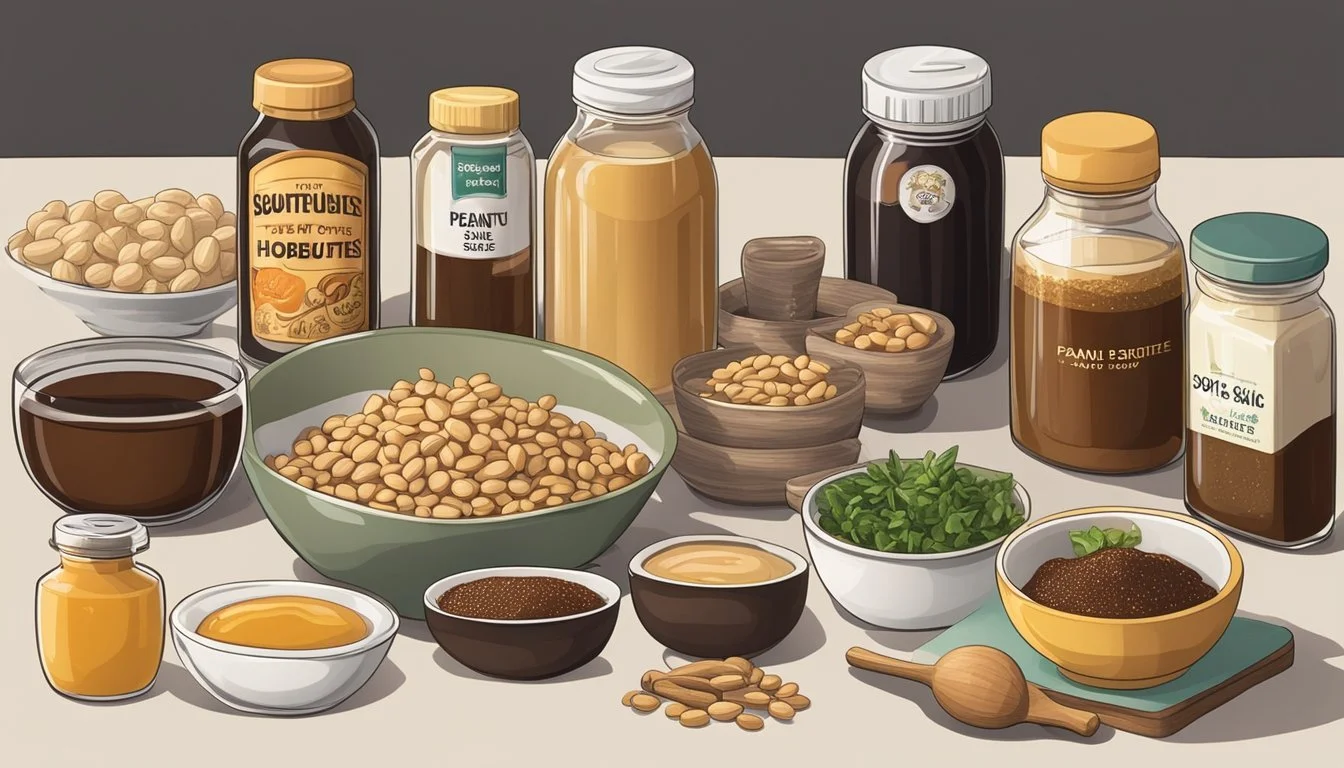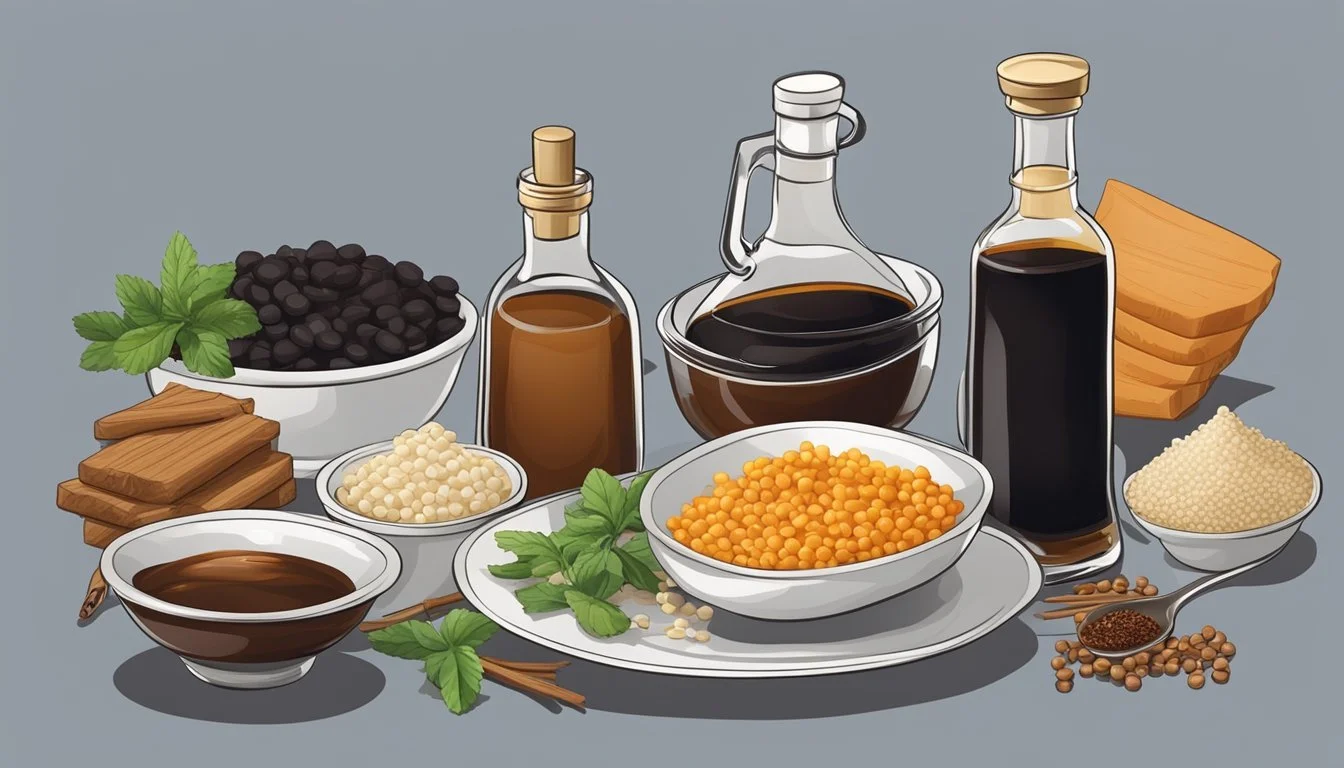Hoisin Sauce Substitutes
Top Alternatives for Your Asian Dishes
Hoisin sauce is a staple in Chinese cuisine, known for its sweet and savory flavors with a hint of spice. It's a versatile condiment that's often utilized in marinades and glazes, as well as a dipping sauce. The unique blend of ingredients like fermented soybeans, garlic, vinegar, and various spices creates its distinct taste. However, when it's not available, knowing suitable substitutes can save a meal and introduce cooks to new flavor combinations.
Finding a hoisin sauce alternative can be an easy fix with common pantry items. Several options can mimic the rich flavor profile of hoisin sauce. Whether using a combination of soy sauce and a sweetener like honey, or employing other sauces such as oyster sauce, one can recreate a similar depth of flavor. It's important to consider the umami quality and hints of sweetness when selecting a substitute, ensuring that it complements the dish similarly to hoisin sauce.
Understanding Hoisin Sauce
Hoisin sauce is a staple in Cantonese cooking, traditionally used as a marinade, stir-fry sauce, and dipping sauce. Its versatility has made it an integral component in Chinese cuisine.
Origins and Uses
Hoisin sauce originated from Cantonese culinary practices, where it's considered indispensable in the kitchen. Made from a base of fermented soybeans, this sauce is thick in consistency and rich in flavor, making it a favorite for marinating meats, especially pork and duck. Its utility extends to seafood dishes and as a stir-fry sauce, adding a robust flavor profile to a variety of dishes. It's also commonly served as a dipping sauce alongside spring rolls and other appetizers.
Taste Profile
The flavor of hoisin sauce is deeply savory with a sweet undertone. The key taste components are:
Sweetness: This comes primarily from the addition of sugar in the sauce.
Umami: The fermented soybeans provide an earthy depth that is characteristic of umami.
A blend of various spices, including garlic, fennel seeds, and red chilies, along with a hint of vinegar, balances the sauce's sweetness with a mild tartness and subtle spice. This combination results in a multifaceted taste that is complex yet well-rounded, enhancing the overall flavor of dishes to which it is added.
Hoisin Sauce Key Ingredients
Hoisin sauce is renowned for its rich flavors derived from an intricate blend of unique ingredients. These components work in harmony to create the sauce's distinctive taste.
Main Components
Soybeans: As the primary base, fermented soybeans grant Hoisin sauce its fundamental texture and depth.
Sugar: Added sweetness is achieved through the inclusion of sugar, balancing the richness of the fermented soybeans.
Vinegar: A touch of acidity from vinegar serves to brighten the sauce’s flavor profile.
Garlic: A crucial aromatic, garlic imparts a pungent and earthy undertone.
Flavor Constituents
Sesame Oil: This oil adds a nutty and toasty dimension, enhancing the complexity of Hoisin sauce.
Soybean Paste: Also known as miso, this soybean paste contributes an umami-packed savoriness.
Spices: A tailored blend of spices, often including Chinese five-spice, lends the sauce its signature warmth.
Seasoning: Additional seasoning elements such as black pepper adjust the overall zest and piquancy.
This section used formatting to enumerate key components and articulate the layering of flavors that constitute Hoisin sauce, focusing on specificity and clarity.
Homemade Hoisin Sauce Alternatives
Creating an alternative to hoisin sauce at home allows for customization of flavors while using accessible ingredients. This section provides a recipe and discusses the ratios of ingredients to help tailor the sauce to individual tastes.
Recipe for Homemade Hoisin
To prepare a simple homemade hoisin sauce, one can start with:
4 tablespoons soy sauce
2 tablespoons peanut butter (smooth)
1 tablespoon honey or molasses
2 teaspoons rice vinegar
1/8 teaspoon garlic powder
2 teaspoons sesame seed oil
1 teaspoon Chinese five-spice powder
One needs to whisk these ingredients together until they get a smooth, uniform consistency. Adjusting the sweetness or saltiness is easy by altering the amount of honey or soy sauce.
Ingredient Ratios for Custom Mixes
For a more personalized hoisin sauce alternative, consider adjusting the ratios of these key ingredients:
Soy Sauce: Base of the sauce, provides saltiness and umami.
Peanut Butter or Black Bean Paste: Gives thickness and depth; peanut butter makes it more savory and nutty, while black bean paste leans towards authentic Chinese flavor profiles.
Sesame Seed Oil: Adds a punch of intense flavor and aroma, use sparingly.
Garlic Powder or Fresh Minced Garlic: Essential for the characteristic garlic note.
Rice Vinegar: Balances the sweetness with its acidic tang.
Sweetener: Honey, molasses, or brown sugar can be used to adjust sweetness.
Fermented Soybean Paste: Can be incorporated for additional depth and a more authentic taste.
This provides a foundational guideline, but one can alter the quantities based on their preference for sweetness, spiciness, or tanginess. Start with the basic recipe and tweak the ratios to match the desired profile.
Commercial Substitutes for Hoisin Sauce
In search of an alternative to hoisin sauce? The market offers a variety of commercial sauces that can mimic its sweet and savory characteristics. These include readily accessible Asian sauces and adaptable Western sauces, which can serve as suitable stand-ins for hoisin in many recipes.
Similar Asian Sauces
Oyster Sauce: While slightly more savory, oyster sauce can be used due to its umami-rich profile and is often utilized in the same types of dishes as hoisin sauce.
Teriyaki Sauce: A bit sweeter with a thinner consistency, teriyaki sauce, when mixed with garlic and extra soy sauce, approaches the complexity of hoisin.
Soy Sauce: Although less thick and sweet, soy sauce can be a base for creating a hoisin-like flavor when combined with ingredients like honey and five-spice.
Miso Paste: This fermenting soybean paste is best diluted with soy sauce and a touch of sweetener to create a depth of flavor similar to that of hoisin.
Black Bean Sauce: Made with fermented black soybeans, this sauce lends a salty and slightly bitter flavor and should be balanced with sweeteners for a hoisin sauce-like taste.
Bean Paste: A more general term that may include pastes like black bean sauce and sweet bean paste, both of which have a consistency closer to hoisin and can serve as alternatives with a few modifications.
Accessible Western Sauces
Fish Sauce: Identified by its potent umami taste, fish sauce can work when sweetened and used sparingly.
Tamari: This wheat-free alternative to soy sauce offers a similar flavor to hoisin when combined with additional sweeteners and spices.
Worcestershire Sauce: With its complex flavor profile, Worcestershire sauce can substitute for hoisin if balanced with sweet ingredients. Its thin consistency should be considered when substituting.
Creating Similar Flavors with Common Ingredients
In the absence of hoisin sauce, a cook can replicate its unique taste by carefully combining ingredients that offer sweetness, umami, and a balance of saltiness and acidity.
Sweetness Balance
Hoisin sauce's sweetness typically comes from ingredients like sugar and molasses. A suitable alternative to emulate this sweetness includes honey or brown sugar. To adjust for a sauce's consistency and sweetness to match that of hoisin, one may consider:
Molasses: Adds a rich, sweet flavor akin to hoisin sauce.
Brown Sugar: Provides a deep sweetness with a hint of caramel.
Honey: Offers a lighter, milder sweetness if preferred.
Umami and Savory Enhancers
For incorporating umami, the savory taste that characterizes hoisin, ingredients such as soy sauce and yeast extract are excellent choices. They contribute the following:
Soy Sauce: Infuses a robust umami flavor along with saltiness.
Yeast Extract: Enhances the savory profile significantly.
Oyster sauce or a mixture of sesame oil could also serve as umami-rich components.
Adjusting Saltiness and Acidity
Balancing the salty and tangy flavors of hoisin sauce can be tricky. White vinegar adds acidity, which can be countered by the inherent sweetness in the substitute mixture. Elements to consider are:
White Vinegar: Contributes the desired tanginess to the sauce.
Combining the vinegar with a sweet component can establish the classic sweet and salty taste.
By mixing these common kitchen ingredients, one can create a sauce that closely mimics the complex flavor profile of hoisin sauce, with the right balance of sweetness, umami, salinity, and acidity.
Hoisin Sauce Substitutes in Recipes
When a recipe calls for hoisin sauce and it's not available, one can rely on various substitutes that can retain the flavor profile of the dish. These alternatives can cater to meat dishes, vegetarian and vegan diets, as well as seafood and stir-fries, offering a diverse range of options for different culinary needs.
Substitutes in Meat Dishes
Meat dishes often use hoisin sauce for its sweetness and depth. A suitable substitute is a combination of barbecue sauce and additional ingredients to mimic the complex flavors of hoisin. One can mix:
1 cup American barbecue sauce
3 tbsp molasses
4 tsp soy sauce
2 ½ tsp Chinese-five spice powder
This blend can be used as a glaze or in marinades for various meats, ensuring to adjust the consistency with water if necessary.
Vegetarian and Vegan Options
For vegetarian and vegan dishes that typically rely on hoisin for umami, a miso-based sauce can be an excellent alternative. Create a mixture with:
Equal parts miso paste and water (for desired quantity)
A squeeze of agave syrup or a vegan sweetener
A touch of garlic powder for added flavor
Adjustments of soy sauce or sesame oil to taste
This sauce can replace hoisin in stir-fries and as a marinade for tofu or tempeh.
Seafood and Stir-Fries
Seafood and stir-fry dishes benefit from hoisin's unique flavor. Oyster sauce, another umami-rich condiment, often fits best due to its similar consistency and taste profile, making it an almost one-to-one substitution for hoisin sauce in seafood dishes. For a vegan alternative, a teriyaki sauce enriched with:
Minced garlic
Additional soy sauce
... can be used, ensuring the sweetness and thickness are appropriate for the recipe.
Specialty Substitutes and Regional Variations
The quest for Hoisin sauce substitutes can take a culinary enthusiast through a tour of East Asian flavors and inspire ingenious use of local pantry staples.
East Asian Variations
In East Asia, regional condiments offer a palate that can match the rich depth of Hoisin sauce. Black bean sauce stands out as an alternative hailing from the Chinese cuisine, providing an umami depth with a slightly bitter and salty profile. Plum sauce, another substitute, resonates with a fruitier essence while retaining a savory finish, which aligns closely with Hoisin's own sweet and tangy character. Kecap manis, an Indonesian sweet soy sauce, is thicker and sweeter than its Chinese counterpart, and Teriyaki, a Japanese sauce, offers a balance of sweet and soy flavors that can mimic Hoisin when garlic is added. Meanwhile, variations like Duck sauce, typically found in American-Chinese cuisine, bring a sweet and fruity quality that can substitute Hoisin in a pinch.
Black bean sauce: Salty and slightly bitter, use in a 1:1 ratio.
Plum sauce: Sweeter, more tart, with a thick consistency.
Kecap manis: Sweeter and thicker than regular soy sauce; use less to avoid overpowering sweetness.
Teriyaki: Add garlic to achieve a closer approximation to Hoisin's flavor.
Adapting with Local Ingredients
Chefs and home cook often adapt with what's available locally, creating variants that echo the essence of Hoisin sauce. A homemade concoction might involve maple syrup for sweetness, balancing it with soy to maintain the sauce's savory foundation. Chinese five-spice powder or Chinese 5-spice, a blend that often includes star anise, cloves, Chinese cinnamon, Sichuan pepper, and fennel seeds, can be mixed with sriracha and a sweetening agent to construct an improvised Hoisin with a spicy kick.
Suggested Mixtures:
Soy + Maple Syrup: Mix these for a base, adjusting sweetness to taste.
Sriracha + Chinese Five-Spice + Maple Syrup: Combine for a spicier, complex substitute.
By staying true to the fundamental flavors of Hoisin—sweet, savory, and aromatic—these specialty substitutes and regional variations offer a spectrum of possibilities for recreating or replacing the original sauce in a dish.
Dietary Considerations for Substitutes
When it comes to finding suitable Hoisin sauce substitutes, dietary restrictions play a crucial role. For individuals with gluten sensitivities or nut allergies, the choice of alternative ingredients must be approached with careful consideration to avoid any adverse reactions.
Gluten-Free Options
For those avoiding gluten, Hoisin sauce can present a problem as it often contains wheat. A gluten-free substitute can be made by using a soy sauce that is labeled as gluten-free, as soy is naturally gluten-free but soy sauces often have added wheat. Combine this with other gluten-free ingredients like molasses and a gluten-free vinegar to mimic the rich flavor of Hoisin sauce. One can also explore premade gluten-free Hoisin sauces available in the market.
Gluten-Free Hoisin Substitute Recipe:
3 tbsp gluten-free soy sauce
2 tsp rice vinegar
1 tsp sesame oil
1/4 cup molasses
1/2 tsp Chinese five-spice powder
Nut-Free and Allergy-Safe Alternatives
Nut allergies require careful attention when substituting Hoisin sauce, as some recipes or commercial products may contain nut products or traces of nuts. Ingredients such as seed-based sauces or nut-free soybean-based sauces should be considered for dipping sauces to ensure safety and enjoyment without the risk of an allergic reaction. Always check labels for potential cross-contamination warnings if allergies are a concern.
Nut-Free Hoisin Substitute Components:
Seed butters (as alternatives to nut butters)
Nut-free soy or tamari sauces
Ensure all spices and additional ingredients are declared nut-free
Using these guidelines, individuals with dietary restrictions can safely enjoy the depth and complexity that Hoisin sauce brings to dishes without compromising on their health needs.
Conclusion
When one's pantry lacks hoisin sauce, a variety of substitutes are readily available, each capable of imparting a similar flavor profile to dishes. These alternatives, while not identical, offer a blend of sweet and salty elements akin to hoisin sauce's unique taste.
For an easy substitute, barbecue sauce mixed with additional ingredients serves well, especially with the inclusion of molasses and soy sauce for depth, and Chinese five-spice for authenticity. Another convenient option is oyster sauce, which, due to its savory umami quality, is a suitable stand-in.
Those seeking a homemade approach may combine soy sauce with rice vinegar and a touch of sesame oil, leveraging the versatility of Chinese five-spice to mimic hoisin's signature flavor. In scenarios needing a sweeter variation, pairing teriyaki sauce with garlic can be effective, acknowledging that teriyaki has a thinner consistency and a different flavor profile.
Below is a summary of the substitutes discussed:
BBQ Sauce Mix: BBQ sauce, molasses, soy sauce, yeast extract, Chinese-five spice.
Oyster Sauce: A straightforward single ingredient alternative.
Soy Sauce Blend: Soy sauce, rice vinegar, sesame oil, Chinese five-spice.
Each substitute should be tailored to one’s taste preferences and the specific requirements of the recipe. They should aim for balance, remembering to adjust quantities to achieve the desired intensity and thickness. It’s important to note that while substitutes can provide a similar essence, the distinctive flavor of hoisin sauce is challenging to replicate perfectly.







